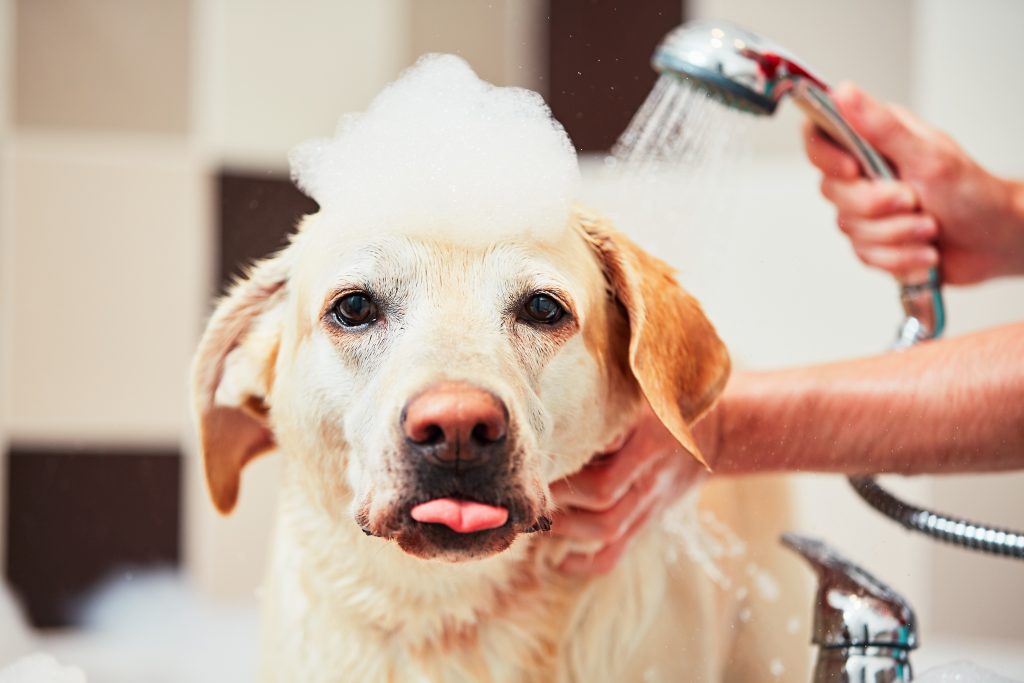You believe that you have one beautiful pooch. In your eyes, his perfection is unmarred and parallel to none. Until that is, you give him a good rub down, and you notice unsightly white flakes appearing everywhere.
You do some more scratching, and you notice your beautiful canine seems to have spots of very dry skin and even a few bumps and sores here and there. You decide you’d better keep an eye on it and decide to observe your pet for the day. In short order, you notice that your dog is itching more than usual.
Well, you’re not crazy, and the condition is not uncommon. It’s actually a case of dog dandruff. Dog dandruff is also sometimes called seborrhea (although seborrhea is actually a cause of dandruff, not the condition of dandruff itself).
Regardless of semantics, your dog can suffer from primary or secondary seborrhea. Secondary seborrhea is the most common affliction. Primary seborrhea is rare and usually genetic, so it gets passed down the family tree.
Secondary seborrhea often results from an underlying cause such as allergies or other skin issues in dogs. Despite the cause, you don’t want your dog to be itchy and uncomfortable, nor is it ideal to have him flaking all over your home. This means treatment measures are in order.
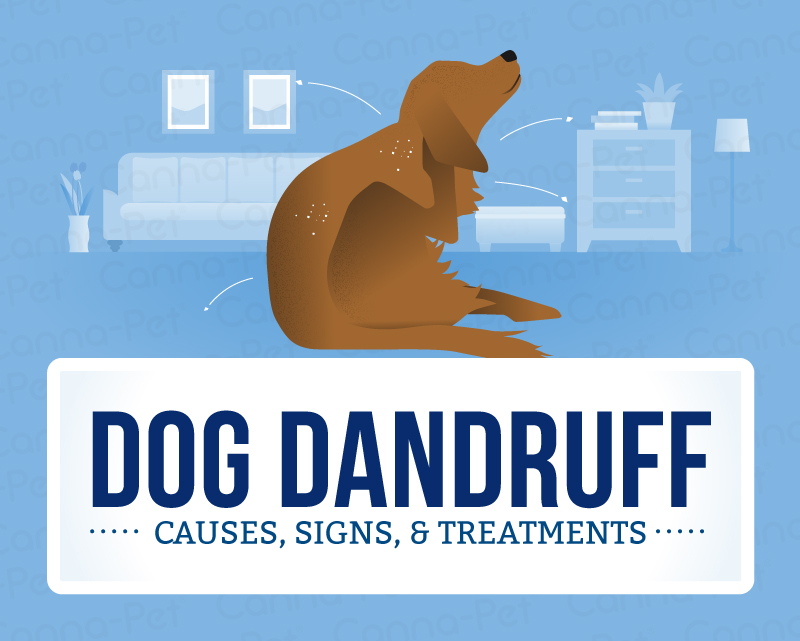
Dog Dandruff – What Causes It?
There are several different causes of dandruff in dogs. They can run the gamut of allergen-related triggers. These allergens can be both food related and environmental. Irritants like pollen and dust, household cleaners, and even the saliva of fleas can be the culprits.
Endocrine disorders like Cushing’s disease and hypothyroidism in dogs can also cause dandruff. Bacterial or fungal skin infections can cause dandruff too, although this will manifest as flakes all over the body, instead of in just one localized area.
- Infections
- Yeast
- Parasites that are both internal and external
- Abnormalities in your dog’s diet (such as not drinking enough water or not getting the proper ratio of fat, minerals, and vitamins that your dog needs)
- Obesity
- Even things such as temperature and humidity levels
These can all be underlying causes of dandruff on dogs. Weather conditions are especially true in the wintertime due to the low humidity levels. These low levels of moisture in the air can leech the moisture from your dog’s skin too, making him itch and scratch and flake.
This can also be said of spring and summer, especially if your dog suffers from seasonal allergies.
Occasionally dogs can suffer from dandruff due to Cheyletiella mites. This is also sometimes called “walking dandruff.” These mites like to burrow into your dog’s skin and coat and lay their eggs. Their goal is to proliferate and generally make your dog as miserable as possible.
Finally, improper grooming can also be a culprit for dandruff, so it’s important to keep your dog clean and well-groomed at all times, to prevent possible infections and infestations. Regular brushing helps to keep your dog’s coat lubricated with oil and prevent dryness and itchy flaking.
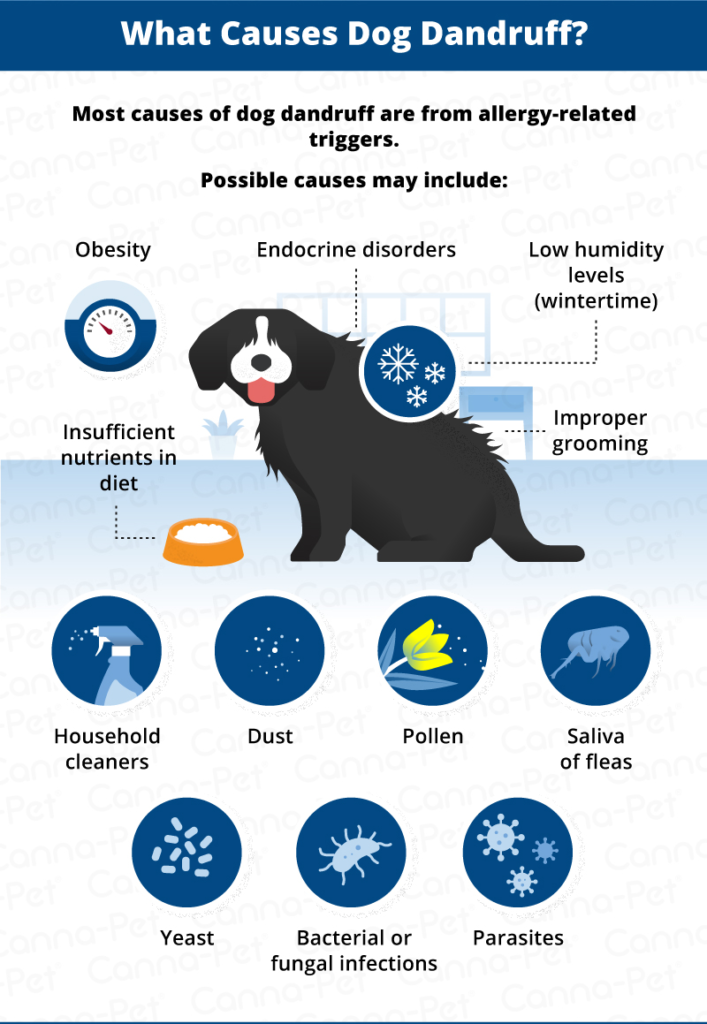
Signs and Symptoms of Dandruff in Dogs
A dog with dandruff will present with either dry, flaky skin, or oily, flaky skin, depending on the breed. Those ugly little flakes are actually dead skin cells all stuck together and flaking off.
Other signs of dandruff are itching and scratching, and you may even notice hair loss and baldness in certain areas, as well as areas where the skin appears “thick”. Scabs, bumps, and pimples can also be a sign that your dog is suffering.
If your dog does suffer from hair loss in addition to the flakiness, you should see your vet. Hair loss in dogs could be a sign of Canine Cushing’s Disease.
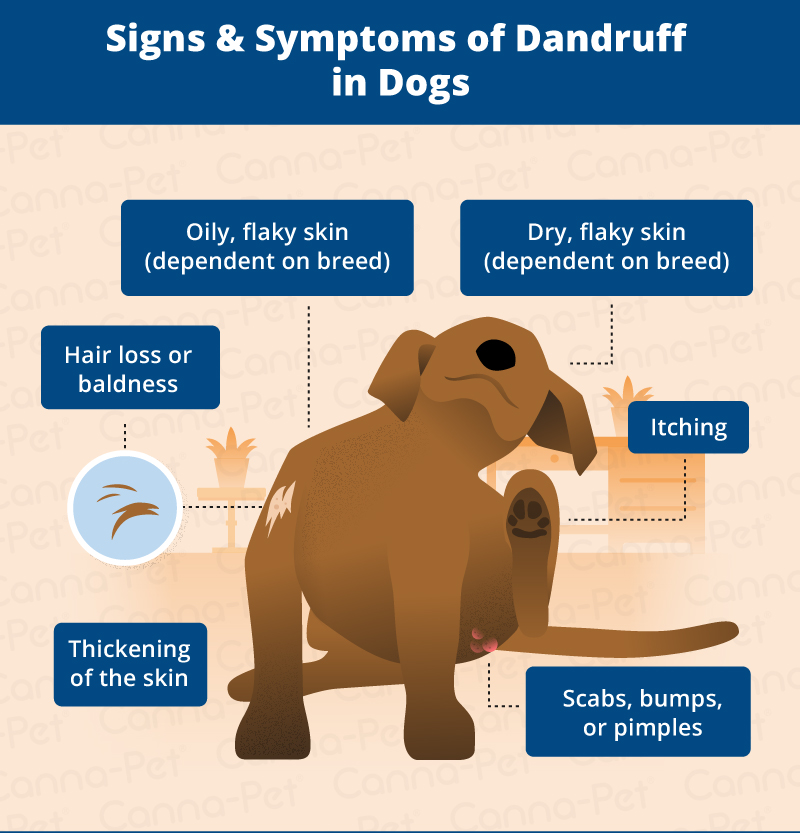
Breeds Predisposed to Oily Dandruff
- Labrador Retrievers
- Sharp-Peis
- West Highland White Terriers
- Cocker Spaniels
- English Springer Spaniels
- Basset Hounds
Breeds Predisposed to Dry Dandruff
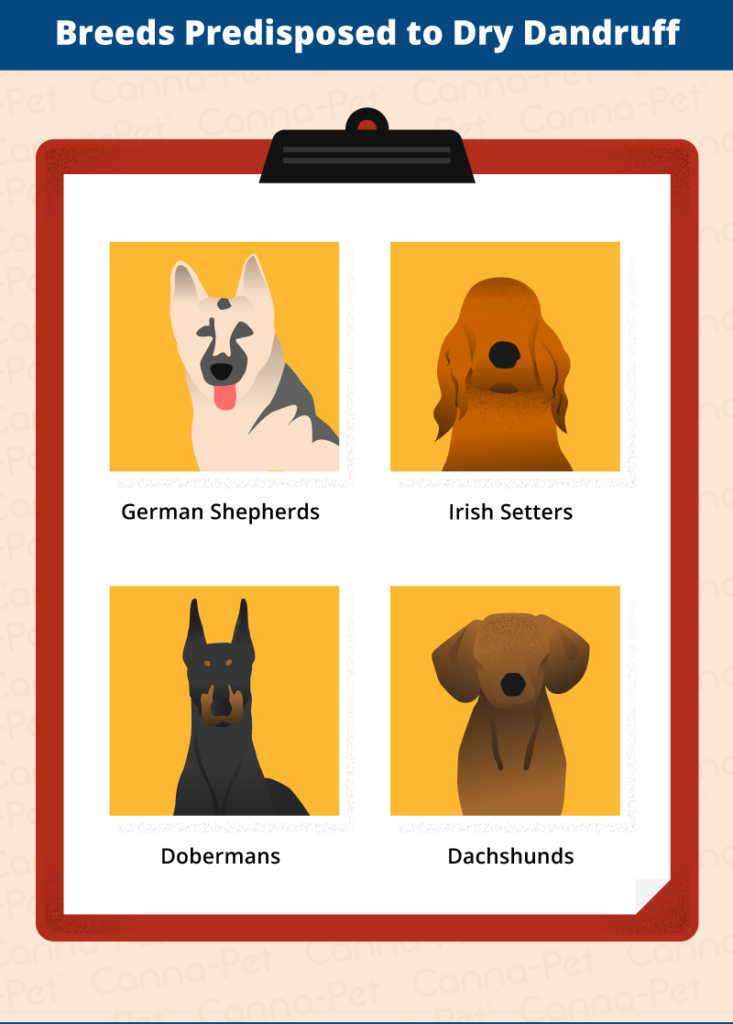
Treatment Options for Dandruff in Dogs
As with everything, it’s important to understand and identify the underlying cause of your dog’s dandruff in order to treat it effectively.
For instance, a round of antibiotics might be needed if your dog is suffering from some type of underlying infection. You won’t know unless you see your vet.
However, if you think it’s just a simple case of dry skin causing the unsightly dandruff, there are some things you can do that will help get the condition under control.
Groom Your Pooch
The first thing you will want to do is make sure your pet is being groomed properly. Your dog must have regular baths and a regular brush down. This will help keep him clean, remove any potential contaminants, and stimulate oil production in your dog’s skin that gives his coat that pretty gleam.
Bathe Your Dog
Make sure you use a shampoo that is formulated for dogs, and you might even consider trying a medicated shampoo. If your dog suffers from “dry” dandruff, you will want to look for a shampoo formulated with iodine, sulfur, or systolic acid.
If your dog suffers from “oily” dandruff, you’ll want to find a product that is formulated with benzoyl peroxide, coal tar, or selenium sulfide.
You can also try a shampoo that is formulated for both types of skin, and that may be beneficial as well. If you find that the shampoo you are using does not seem to be helping much, don’t be afraid to try another. Sometimes trial and error is the best way to reach a solution.
How Often Should You Bathe Your Dog?
This really depends on how severe your dog’s dandruff is. If it’s very bad, you might consider bathing your dog every other day for at least a week or two. When you see that most of the flakiness has disappeared, and any sores and bumps seem to be healing, you can reduce bathing to twice a week, and then eventually to once a week. You can even drop down to once a month, once you see that the dandruff is fully under control.
Consider Your Dog’s Diet
Dietary issues can play a big role in treating and preventing dandruff. Your dog needs to consume the proper amount of nutrients to have optimal health, including the health of his skin.
To make sure he is getting what he needs, you can offer your dog supplements, such as zinc and vitamins A and E. The zinc will help boost your dog’s immune system, while vitamins A and E will nurture his skin.
You can also give your dog fatty acids with Omega 3’s to help keep his skin and coat healthy. Fish oil is an excellent option for this.
Other dietary considerations include making sure your dog consumes enough water each day, and if you think that he isn’t drinking enough, you may have to get creative and try adding water to his food, or flavoring his water with something tasty like juice from a canned food.
Consider a Humidifier
Humidity levels play a very big role in the cause of dandruff in dogs, so a humidifier can help mitigate the effects of low humidity. This is especially helpful if you live in a very dry area, and is also helpful in the winter when humidity levels are naturally low. It’s also healthy for you too!

Treating Cheyletiellosis or “Walking Dandruff”
Treatment for this condition will be different from treating regular dog dandruff, as mites are the culprits here. Because mites are the cause, your dog may need to undergo regular weekly treatments with a lime sulfur dip. You may also need to use pyrethrin shampoos and sprays.
Sometimes flea control medications may be recommended, and in severe cases your vet may consider a drug called Ivermectin. This drug is administered subcutaneously or orally, and may not be recommended for all breed types, as it can be toxic to some of them.
Unfortunately, these mites are highly contagious, which means that all four-legged family members must be treated, as well as all bedding, carpeting, and furniture.
Think of it like trying to get rid of lice with humans. Mites are the doggie equivalent. When in doubt, wash all linen and fabrics, and scour all surfaces to prevent future infestations. You may also consider spraying your house with a residual insecticide.
Treating Dog Dandruff Naturally
Try a Lime Juice Rinse
Lime juice is loaded with vitamin C, which can help considerably with dog dandruff. Combine equal parts water with the lime juice, and rinse your dog with it after you have bathed him with shampoo. This can be great if you combine it with a natural oatmeal shampoo, as oatmeal is very soothing for itchy, flaky skin.
Apple Cider Vinegar Rinse
Like using lime juice, an apple cider vinegar rinse can help control both dandruff and itching. Again, you should mix equal parts apple cider and water, and then apply the solution to your dog either as a rinse after his bath, or spot apply to particular areas with a soft cloth. Let the solution dry on your dog’s skin, and repeat this process every day until you see improvement.
Coconut and Olive Oil for Moisture
Olive oil makes a great moisturizer, and you can rub it into your dog’s fur and skin every day. Coconut oil is also great for moisturizing, although you may want to try mixing the coconut oil with water and using it as a rinse instead. Let the rinse set on your dog for a few minutes, and then wash and shampoo as usual. You can try the coconut oil once a week, however you can apply the olive oil daily.
Soothing Fenugreek Paste
Fenugreek is similar to oatmeal with its relief properties for dry and itchy skin. You can simply soak a couple cups of the fenugreek seeds overnight to soften them up, and then mix them with more water the next day to make a paste. Use the paste all over your dog, and let it set for an hour or so. Then wash and shampoo your dog as normal.
Listerine Mouth Wash Rinse
Another potential home remedy treatment you can try is using Listerine mouthwash as a rinse. It sounds a bit odd, but due to the ingredients, which are menthol, thymol, and methy salicylate, it can be helpful with fungal infections and yeast, both of which cause dandruff.
You will want to dilute the Listerine with equal parts water, and then use it as a rinse before your dog’s bath. Let it sit for a bit, and then after 10 minutes you can bathe your pet as normal.
Milk of Magnesia
There’s nothing to mix this particular treatment with, you can just rub it into your dog’s fur and skin, let it sit, and then wash him after about 30 minutes. This has been a natural remedy used with both humans and animals alike for many years, so it can’t hurt to try it with your dog.
Remember, your dog does not have to suffer indefinitely with this condition. If you notice the signs of dog dandruff, and take the proper steps to treat both the symptoms as well as the underlying cause, you can get the condition under control.
Once you’ve got it under control, you’ll be rid of those unsightly white flakes that have been marring the beauty of your four-legged friend.
With regular maintenance care and treatments, you can reduce or eradicate your dog’s discomfort, and get rid of your dog’s dandruff for good.

Sources:
- “Dog Dandruff: What Causes It and How to Treat It.” Petful, 23 July 2018, Accessed 24 Aug. 2017. www.petful.com/pet-health/dog-dandruff-causes-treatments/.
- Burke, Anna. “Common Causes & Remedies for Your Dog’s Dry, Itchy Skin.” American Kennel Club, 19 May 2016, Accessed 24 Aug. 2017. www.akc.org/expert-advice/health/dry-skin-on-dogs-causes-symptoms-treatment/.
- “7 Home Remedies for Dog Dandruff.” Care.com, Accessed 24 Aug. 2017. www.care.com/c/stories/6309/7-home-remedies-for-dog-dandruff/en-gb/.
- “6 Tips on How to Get Rid of Dog and Cat Dandruff.” PetMD, Accessed 24 Aug. 2017. www.petmd.com/dog/grooming/evr_multi_dandruff_free_pet.
- “5 Ways to Treat Dog Dandruff.” PetMD, Accessed 24 Aug. 2017.www.petmd.com/dog/slideshows/5-ways-treat-dog-dandruff.

